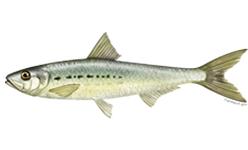West Coast Sardine Decline: Science vs. Politics
Diane Pleschner is E.D. of a California group representing baitfish/forage fish producers on the Pacific Coast. Her take on scientific management of fisheries, versus emotionally and politically-driven management, is worth a read for all anglers and outdoorsmen, whether we’re looking at forage fish or gamefish. FSBy D.B. Pleschner, Guest commentary
from The Fishing Wire
The federal Pacific Fishery Management Council has shut down the remainder of the current sardine season and has canceled the 2015-16 fishing season altogether. Fishermen supported this action.
Why the closure? According to environmental groups like Oceana, it was to stop overfishing and save starving sea lions deprived of essential sardines.
Neither reason is true, but many in the media have trumpeted this hyperbole put forth by groups whose political agenda is to shut down fishing completely.
The scientific facts present a different picture: the sardine population is not overfished. And sea lion mortality has not been caused by overfishing sardines.
As Dr. Ray Hilborn, professor in the School of Aquatic and Fishery Sciences at the University of Washington and one of the most respected experts on marine fishery population dynamics in the world, recently noted, “Even if there had been no fishing, the decline in California’s sardines would have been almost exactly the same.” Dr. Richard Parrish, another esteemed scientist with deep knowledge of sardines and ocean cycles, outlined how natural mortality and predation consume five times more sardines than the fishery harvests.
The truth is that the marine environment plays the major role in determining the size of the sardine stock and its effect on the ecosystem.
Dr. Kevin Hill, a fisheries scientist with the Southwest Fisheries Science Center who leads West Coast sardine stock assessments noted that, “Pacific sardines are known for wide swings in their population: the small, highly productive species multiplies quickly in good conditions and can decline sharply at other times, even in the absence of fishing. You can have the best harvest controls in the world, but you’re not going to prevent the population from declining when ocean conditions change in an unfavorable way.”
That’s why the sardine harvest control rule — developed in part by Parrish for the management plan in place since 2000 — automatically regulates the sardine fishery both by reducing the fishing quota and reducing the harvest rate as the stock declines. And it shuts down the fishery if the biomass falls below 150,000 metric tons.
The 2015 sardine population is estimated to be 97,000 metric tons, a worst-case projection, and the control rule did exactly what it was designed to do — it closed the fishery after a series of poor recruitment years.
The sardine fishery would have been shut down regardless of the frenetic lobbying of groups like Oceana. The goal of the policy is to keep at least 75 percent of the sardine population in the ocean.
Regarding the sea lion problem, the El Niño cycle that we’re experiencing is a major reason for increased pup mortality, not the lack of sardines. Sardines comprise a minor portion of sea lions’ diet. According to NMFS scientist Mark Lowry, who has studied sea lion scat for 30 years, sardines number eighth on the list of typical sea lion dietary preferences.
The sea lion population has increased 5 percent a year even without sardines.
Pup counts dipped during the 2003 El Niño also, and we’re experiencing another El Niño event now. Yet the sea lion population has grown by 600 percent since the mid-1970s; they now hog docks and sink boats from Southern California to the Pacific Northwest.
Hardworking fishermen take pride in the precautionary fishery management that’s been in place for more than a decade, and they resent groups who demonize them for “overfishing.” It’s an unjust and erroneous accusation leveled at people trying to make an honest living, provide a service to the public and do the right thing for the environment.
The fact is that sardines are critically important to California’s historic fishing industry as well as to the Golden State. The “wetfish” industry fishes on a complex of coastal pelagic species also including mackerels, anchovy and market squid, but sardines are an important part of this complex. The industry produces on average 80 percent of total fishery landings statewide and close to 40 percent of dockside value.
Thankfully the Pacific Fishery Management Council recognized the need to maintain a small harvest of sardines caught incidentally in other CPS fisheries. A total prohibition on sardine fishing would curtail California’s wetfish industry and seriously harm numerous harbors, including Monterey, as well as the state’s fishing economy.
D.B. Pleschner is executive director of the California Wetfish Producers Association, a nonprofit dedicated to research and to promote sustainable Wetfish resources.
